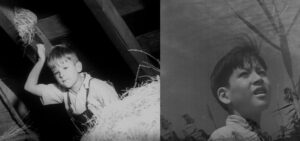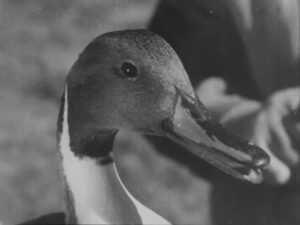IULMIA has chosen to showcase Irving Jacoby’s 1942 High Over the Borders as another of the outstanding films recently digitized for our soon-to-be expanded online exhibit WWII Propaganda Films and IU. Over 80 new titles from IULMIA’s collections will be available for viewing as part of this curated project that explores the distribution and exhibition of propaganda, educational, and training films on 16mm by the I.U. Extension Division throughout World War II.
An area of special focus in the exhibit is the WWII-era film productions of the Office of the Coordinator of Inter-American Affairs (OCIAA). High Over the Borders is one of seventeen OCIAA productions viewable in the expanded exhibit, drawing attention to a body of remarkable films reporting on the nations of the Americas, many of which have not been widely available for viewing and study outside of archival collections.
Irving Jacoby was a member of an influential early generation of documentary filmmakers who went to work for governments of the Allied nations as war broke out, making a contribution to the war effort, developing their craft as filmmakers, and producing films of lasting value in the process. In the U.S. the OCIAA employed a remarkable roster of civilian filmmakers to create films showing life in the U.S. to the southern nations of the hemisphere, and educating U.S. audiences on the culture and geography of the Latin American countries.
The Pan-Americanism of Franklin D. Roosevelt’s Good Neighbor policy, and the Office of the Coordinator of Inter American Affairs, under the direction of Nelson Rockefeller, sought to boost political and economic relations between the U.S. and Latin American nations. Before war broke out this U.S. public relations campaign worked to improve relations and counteract an imperialist image prevailing the south. Soon after the war began the OCIAA hastily shifted its priorities toward working to assure hemispheric solidarity, and preventing South American nations from any undue alliances with the Axis. In late 1941 a program of motion picture production and distribution by the OCIAA commenced, intending to use films to “show the truth about the American Way” to southern nations. A report on the new OCIAA film program in a December, 1941 issue of Motion Picture Herald makes mention of Irving Jacoby’s work-in-progress, referring to the film by the working title As Birds Link the Americas.
Completed early the following year, an announcement appearing under the heading “Good Neighbor Film” appearing in the April, 1942 Movie Makers (via Media History Digital Library) provides the basic details of the production:
The seasonal flights of birds all over the American Continents, irrespective of boundaries and man made laws, constitute the theme of High Over the Borders, a two reel movie prepared jointly for the Office of Inter American Affairs, the National Film Board of Canada, and the New York Zoological Society. Most of the footage came from the newsreel and nature footage libraries of the National Film Board, while John Ferno did the camera work and the editing. Irving Jacoby was the writer and director, Phil Brown was the narrator and Vittorio Giannini composed the musical score. The National Film Board is handling theatrical distribution in both Americas, while the Office of Inter-American Affairs takes care of the non theatrical circulation in South America.

Having worked in London under John Grierson’s General Post Office (GPO) film unit (occupying W.H. Auden’s recently vacated writing position) from 1938-39, Jacoby was among the first filmmakers to join Grierson in Ottawa, Ontario as the newly forming National Film Board of Canada was taking shape. In the logistics of its production, as well as in its thematic content, High Over the Borders embodied the internationalist message intended by Jacoby and the OCIAA. The migratory journey of barn swallows from the Ontario farm of young Richie, to their wintering grounds over 7000 miles south to coastal Peru, near the village home of Richie’s counterpart Ricardo, serves as a narrative thread through the film. With Grierson the Scot as producer, Jacoby the New Yorker writing and directing, and the Dutch John Ferno (given name Johannes Fernhout) shooting and editing, this U.S.-Canadian co-production was to be exhibited in all corners of the hemisphere, with 16mm prints following the north-south routes of the birds themselves.
An excellent entry on Irving Jacoby by Cecile Starr (herself a fascinating filmmaker and author) in the Encylopedia of the Documentary Film makes brief mention of this early production in Jacoby’s career:
For the NFB, in association with the New York Zoological Society and the [OCIAA], Irving Jacoby produced, directed and wrote High Over the Borders, an appealing, straightforward film about bird migration between North and South America. Tinged with the spirit of internationalism, Dutch filmmaker John Ferno gave Jacoby first-hand experience in balancing the exigencies of organizations and government agencies with his own artistic and social concerns. High Over the Borders was a major success in every way.

The text of Jacoby’s narration drives home the metaphoric significance of migratory bird routes for the message of internationalism. After their southward migration, Canada geese are “full fledged residents of a new country, by virtue of the laws of nature and their power of flight. A thousand miles are nothing, borders do not exist, for the birds have in their wings a passport to the world.” Later we hear the narrator proclaim that migratory birds “mock the man-made lines by which nations separate themselves. For the birds are free, they are at home in the hemisphere, to them belongs all the land over which their wings carry them, and they belong to all the peoples who live in those lands.”
Turning away from propaganda toward a tone of more conventional nature education, the film shows the motion picture camera as an instrument of scientific study. In what was apparently a contribution of the New York Zoological Society’s participation in the production, footage using “super-speed photography” reveals that the ruby-throated hummingbird makes 75 wing strokes every second. According to this essay on nature film by scholar Helen Sommer, the hummingbird footage appearing in Jacoby’s film originated from Nazi government research in high frame-rate photography:
Friday, February 2, 1940: During a meeting at the Institute for Women’s Professional Relations, Mr. Osborn, from the New York Zoological Society, gave a speech on the topic of photography; both as a tool in scientific research and as a form of record for science. He recalled an incident when the society borrowed from Germany a truly remarkable slow-motion-film; 1,200 exposures a second showing the flight of a hummingbird. He reveals apologetically that it was later discovered that the origin of the film was the German Government, more specifically, the Nazi division of Ballistics and Aeronautics. Consequently in 1942, Osborn appropriated the Nazi hummingbird footage in a Canadian/American production: a documentary called High over the Borders, about bird migration in the western hemisphere. The thought of the hummingbird being turned against democracy frightened Osborn to such an extent that he appropriated it into another context in an attempt to rescue it.
The film then turns to the patient and less glamorous work of the U.S. Fish and Wildlife Service, protecting migratory birds by providing sanctuary and regulating sport hunting. The use of banding in scientific study of migration is explained and a vast card file of data gathered by fieldworkers around North America is shown housed in Washington D.C.. Species maps charting migration data – and the 30,000 letters reporting banded bird sightings around the hemisphere received every year – are maintained by the Fish and Wildlife Service. Maps of the Atlantic, Mississippi, Central, and Pacific flyways across the hemisphere are animated.
Returning home to New York City after his Canadian stint, Jacoby, along with documentarian Joris Ivens, persuaded the City College of New York to create an Institute of Film Technique, instructing students in production of non-fiction films during the wartime boom years of training and instructional film production. The institute would go on to greater fame under the leadership of the German expatriate abstract filmmaker Hans Richter, from 1943 to 1946.
![From The Educational Screen, February, 1942 [http://archive.org/stream/educationalscree21chicrich#page/78/mode/2up]](https://blogs.libraries.indiana.edu/wp-content/uploads/2015/05/City-College-Film-Study-Courses-300x231.png)
After leaving the Institute of Film Technique in 1943, Jacoby went on to become chief of the Non-Theatrical Section of the Office of War Information (OWI) Overseas Branch. During his tenure at OWI Jacoby wrote and produced Henwar Rodakiewicz’s short film Capital Story, IULMIA’s catalog record gives this brief summary:
Tells the story of the part played by the U.S. Public Health Service in tracing the cause of a lung infection contracted by a shipyard worker. Details of the tracing of the poison cadmium to a small order of flanges are pictured.
Jacoby concluded his tenure in governmental film production in 1946 with The Pale Horseman, a documentary on the postwar problem of epidemic disease, and the work of the United Nations Relief and Rehabilitation Administration (UNRRA) in aiding European and Asian nations devastated by the war.
Founding Affiliated Film Producers in 1946 with Henwar Rodakiewicz, John Ferno, and Willard Van Dyke (distinguished filmmaker, educator, and later director of MOMA’s Department of Film), marked Jacoby’s turn to private production for the post-war educational film and television market. Jacoby served as writer and producer on a series of short films in the social guidance vein, produced to accompany the Mcgraw Hill textbook Marriage For Moderns. Offering “guidance for young people in the preparation for successful marriage,” the films are perennially popular viewing at Prelinger archives.
A 1947 documentary on Edward Weston, The Photographer, a series of well-regarded films on mental health produced with his wife Alberta Altman, and a 1960 Academy Award nomination shared with Shirley Clarke and Willard Van Dyke for their 1959 short documentary Skyscraper, are among the highlights of Jacoby’s later career.
![from Business Screen No. 8 Vol. 20 1959 [http://www.archive.org/stream/1959businesss1960creenmav20v21rich#page/n637/mode/2up]](https://blogs.libraries.indiana.edu/wp-content/uploads/2015/05/Business-Screen-Magazine-No-8-Vol-20-1959-300x198.png)
Too little seems to have been written about Jacoby, despite the fact that the many films written, produced, and directed by him have been shown around the world for the past 70-some years. In every period of his career Jacoby was closely involved with the influential figures and major developments in the evolution of documentary and educational filmmaking. A search of IULMIA’s catalog returns at least 18 titles that Jacoby played some part in.
In addition to the many Affiliated Film Producers titles available at archive.org, an early National Film Board production Hot Ice (1940) can be viewed online. Also, James Beveridge’s 1978 book John Grierson: Film Master includes a transcript of an interview with Jacoby conducted for the 1973 documentary film Grierson.
Before the expanded WWII Propaganda Films and IU online exhibit is released on June 6, we’ll have one more post here featuring another exemplary war era film recently digitized by IULMIA, the 1943 short Farmer At War. This co-production of the Office of War Information and the War Activities Committee of the Motion Picture Industry profiles the stoic Pennsylvania Dutch farming communities of Lancaster County, a film intended to inspire citizens to greater thrift and cooperation in their contributions to the war effort.
~ Seth Mitter
Leave a Reply